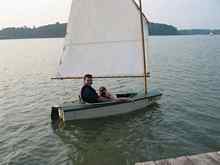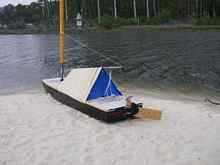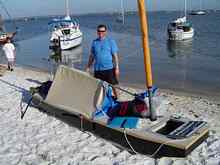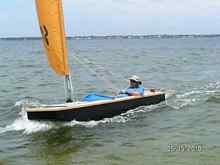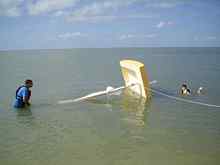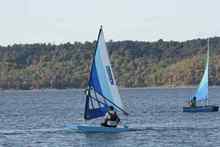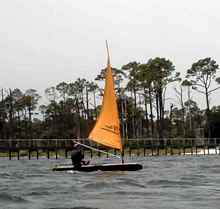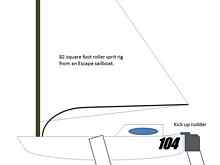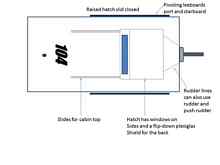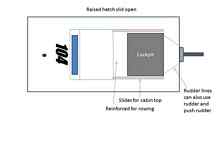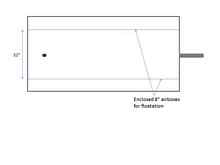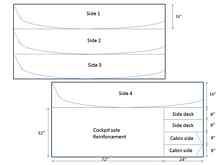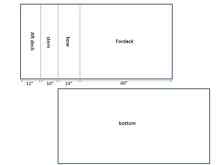
 Custom Search
|
|
| sails |
| plans |
| epoxy |
| rope/line |
| hardware |
| canoe/Kayak |
| sailmaking |
| materials |
| models |
| media |
| tools |
| gear |
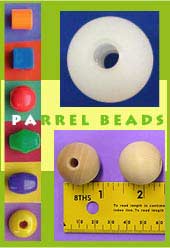 |
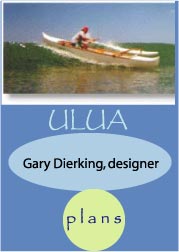 |
| join |
| home |
| indexes |
| classifieds |
| calendar |
| archives |
| about |
| links |
| Join Duckworks Get free newsletter Comment on articles CLICK HERE |
|
|
| A PuddleDuck and the Everglades Challenge - 2 |
by Scott Widmier - Kennesaw, Georgia - USA |
Part One - Part Two - Part Three
The Design Process and BuildIn my previous article I detailed a science experiment seeking to combine the Everglades Challenge with a Puddle Duck Racer. The Everglades Challenge is a 300 mile cruise/race down the Gulf coast of Florida from Tampa Bay to Key Largo. The Puddle Duck is a 4 foot by 8 foot box designed by "Shorty" Routh as an easy to build and sail developmental class racer. There are certain "filters" in place at the Everglades Challenge that limit what boats can participate that may prove to be too much a challenge to the Puddle Duck Racer design primary among these the requirements to sail 60 miles in 29 hours. The maximum cruising speed of a Puddle Duck Racer is between 3 to 4 mph downwind. Add the extra miles if you need to tack to sail to windward and you can begin to see why people have doubts about the feasibility of doing the Everglades Challenge (EC) in a Puddle Duck Racer (PDR). I admit, I was that kid who would do a lot of different things on the playground due to the magic words "You Can't Do That!." So, when those magic words repeatedly arose during several discussions of doing the EC in a PDR, I found myself pulled to the challenge. The final trigger that brought me actually try was Shorty basically giving me the equivalent of "I Dare You!" I wonder if we ever played on the same playground and if he was the kid that got me to eat sand... Design ImperativesFirst step is to design the Everglades Challenge Puddle Duck (ECPDR) that I will be spending a lot of time in sailing down the coast of Florida next March. There are certain requirements that I came up with from my experiences with PDRs, cruising small boats, and with the EC: 1. Performance: The ECPDR has to sail well especially to windward, not a PDR's strong point. Even if the weather cooperates, I will find myself having to make progress to windward possibly in a tight channel. The DesignComfort and ShelterPrior to taking on this challenge, I had spent a bit of time thinking of designs for a cruising PDR with my primary concern being comfort both on the water and off. Any cruise taken in a duck is guaranteed to bring a lot of water time and the need for a good night's sleep as the accounts out of the Texas 200 would attest. I have looked at several PDRs with cabins which provided storage and evening shelter from the wind but they all had the cabin in the front of the boat where it only provided some spray protection when sailing. Here is a great video of Jason Nabors in Tenacious Turtle during the Texas 200. As you can see from the video, he is sitting on the very back corner of the transom to keep the bow out of the water. This is likely due to the amount of stuff that is stored in that forward cabin affecting the overall trim of the boat. The forward cabin also puts windage where it is least needed, in the front of the boat. Steve Gully notices the impact of windage on his forward cabin on Mystery 2 even though the cabin is rather low and small. Instead, I contemplated a rear cabin inspired, in part, by Matt Layden's (Wizard in the EC) designs including paradox and sea flee. With the proper controls, you can sail a boat from a rear cabin completely protected from the elements including sun, rain, and wind. Using a rudder line or push/pull tiller, you can even sit comfortably facing forward in a cushioned seat with back support. One of the most comfortable boats to sail that I have ever built was a modified Gavin Atkin Flying Mouse which had a built in reclining seat and a push/pull tiller.
A rear cabin also gives some advantages when sleeping in the evening especially if the 5 foot or so in front of the cabin is open. You can simply slip your body forward and down to sleep with your feet tucked under the front deck and your trunk and head in the higher headroom rear cabin area. Probably the best-known historical boats to use this method were the Barnegat Bay Sneakbox which were designed for multiday hunting trips. In fact, I was inspired by this design enough to make a similar boat using Gavin's flying rat as a platform. I called this 12' boat Queequeg's Coffin after the coffin used as a lifeboat in the literary masterpiece Moby Dick. Besides, the boat sort of did resemble a coffin when I was through with it. I used this boat for the 2010 Florida 120 but found the leeboard to be undersized for coastal sailing especially when confronted with tall chop in light winds. The chop would slow the boat to the point that the leeboard didn't have any bite and the boat would slip to leeward making no progress towards the goal. Still, the sleeping accommodates, while spartan, were comfortable and easy to set up. I also tried and loved a tiller rope setup where lines came off the rudder yolk and went around the inside of the cockpit through a series of pulleys. Not only did this steering setup avoid the embarrassing "dropping of the push pull tiller pole" but it also made the helm somewhat self
Based upon the above information and experiences, I decided to design a rear-cabin PDR with tiller lines that I could sit comfortably inside facing forward. This will satisfy both the comfort and shelter options nicely. I can already picture myself sitting on my comfortable ratcheting blue boat seat in the shelter of the enclosed aft cabin protected from cold, rain, and sun. I can also picture sailing the boat to a beach or throwing an anchor over the side in a protected cove then slipping down into the boat to stretch out and catch some rest with very little setup required. I could also picture myself so comfortably ensconced that I fall asleep and wind up running into something, or worse, somewhere in the middle of the Gulf of Mexico! Ok, some potential down side to this design. Stores and SeaworthinessThe bane of many boat designs is the lack of space for stuff. Of course, I blame part of the problem on the skipper bringing too much stuff! As I have gained experience in sailing long distance in small boats the amount of stuff I bring along decreases. Less stuff actually is safer than more for several reasons including not overloading the boat, being able to find what you need when you need it, and being able to manhandle your boat around on land. In the December "Reports" in Duckworks magazine, I published an article laying out my slimmed down kit for these type of adventures. I estimate I should be able to keep the weight of my stuff down to 20 lbs including foodstuffs but not water. The required storage space should also be correspondingly small allowing me to share valuable cockpit space with my dunnage. I plan on storing my stuff in clearly labeled and rugged waterproof bags which I will be able to move around inside of the boat to improve trim. The ability to adjust trim is very important given the aft cabin design detailed above. Color coded ropes will help me retrieve the bag I need when I need it. I also spent some time contemplating both the height of the sides of the EC PDR as well as the location of the built in floatation. The class rules for PDR racers restrict the bottom 10 inch of the hull to set dimensions. You can build a duck with 10 inch sides if you want to but be prepared to get wet which is not a pleasant or safe prospect for a going 300 miles on the water in March. However, higher sides translate into more weight and greater windage both of which have a detrimental impact on performance. Part of the reason I was so fast at the 2011 PDR worlds were the low 12 inch high sides on my duck along with its light weight. So, I was faced with a Goldilocks dilemma seeking that just right compromise between comfort and safety with high sides and performance with low. In the end, cut diagrams dictated 16 inch high sides being the best dimensions to get out of a standard sheet of plywood. As for floatation, I have been a fan of side airboxes for PDRs since my first duck. Eight inch airboxes allows the boat to float nicely on its side and come upright without any water in the cockpit. In fact, on my last duck it was quicker to tip the boat over to get the water out of the cockpit than to deal with a bucket and sponge. So, side airboxes with limited access. Floatation is sacrosanct and shouldn't be compromised for storage.
Performance and SeaworthinessSo, having come up with a design that would keep me nice, rested, and toasty, I turned my attention to the requirement of performance. This is the Achilles heel when it comes to a Puddle Duck doing the Everglades Challenge; it just isn't a fast boat! The Portsmouth handicap on a PDR is 140 and, for those of you who don't race, that is slow. Part of this slow performance comes due to the shape of the hull and, by the rules set forth by Shorty, cannot be changed. The short waterline limits the top speed of the duck, the bow transom can dig into waves slowing the progress of the boat, and the shape of the rocker makes it hard for the PDR to get up on plane and exceed hull speed. Ironically, these are the characteristics which make it such a perfect boat to race with acting as an equalizer of rigs and skippers in the PDR races. The other problem with PDR's is their windward performance but this is definitely something I can work on! Windward performance is determined by two things, the sail and the underwater foils. When it comes to the sail, the general rule of thumb is the longer the luff (front side of the sail) the better the windward performance. This is why we see so many three sided sails on the water rather than four sided; the three sided sails have longer luffs and better windward performance. Ironically, the four-sided sails are faster downwind and reaching but, this doesn't matter in racing, as a majority of time or distance on a sailboat racecourse is spent going to windward. The underwater foils provide the countervailing force that makes the boat go forward rather than sideways downwind (we call this leeway). Think of shooting a pumpkin seed out of your fingers. You squeeze the seed between two fingers and the slimy little devil goes shooting out to escape the force acting on it from two different directions. A sailboat operates much the same way and the better the underwater foils, the better the force resisting the push of the sail, and the better the speed to windward. The foils include the rudder and the leeboard, daggerboard, or centerboard and they need to be both of sufficient size to bite the water and of a proper foil shape which helps give lift to windward. The PDR I took to Sail Oklahoma had a rudder and daggerboard of truly heroic dimensions suitable for a much larger boat. However, they gave me good purchase on the water even if the boat had almost been brought to a halt by a wave on the bow transom. This allowed me to make progress to windward both quickly and without too much leeway. In addition, I was using a windsurfing rig which has a leg-of-mutton three sided sail with a long and nicely shaped luff. The whole thing looked like a wing on an airplane and the wind flowing over that shape pulled (lifted) the boat to windward extremely well. Net result was a boat that could outpoint the other PDR's to windward allowing me to win both races I participated in. This was in spite of being a little slower downwind than some of the lug sail rigged competitors. So, I know the secret of going to windward! Accordingly, one rig option I considered was using the windsurfer rig on the EC PDR. This would definitely give me good windward performance but, was the sail rig large enough? My previous duck weighted in at 60lbs and I sailed her with no stores on board. EC PDR would weigh in a lot heavier than that needing to be more robust to withstand the pounding she would receive. In addition, she would have stores on board. In addition, a windsurfer rig is not reef-able which is of big concern since every EC has featured high winds at times. Ok, you could probably make some sort of accommodations to reef the sail but you would most likely lose the nicely shaped luff and your windward performance along with it. So, using the windsurfer rig would maybe satisfy Performance but would not satisfy Seaworthiness.
Unfortunately, I couldn't reef this sail which made things exciting at times. Another rig option I had in my workshop was a very interesting leg-of-mutton rig off of an Escape brand sailboat. What makes this rig unique is the ability to roll up the sail around the mast allowing you to dial in any amount of sail you needed for the wind conditions. This ability was given by a special ball bearing collar around the foot of the mast along with a deck rather than mast mounted boom. The boom has the added advantage of being self-vanging meaning it doesn't kick up in the wind changing the shape of the sail which negatively impacting performance. This was the sail I used in Queequeg's Coffin during the 2010 Florida 120 and you will already have seen it in the photo of that boat sailing above. Though it too has a long luff, this escape rig isn't as good at sailing to windward as the windsurfer rig in my experience. I think it has something to do with the shape of the sail and the straight luff all to accommodate being rolled around the mast rather than optimum performance. Still, it should be closer winded than a four sided sail and the ability to easily roller-reef the sail is a definitely plus when it comes to seaworthiness of the boat. It also is a bigger sail which should push the more heavily laden EC PDR nicely even in light winds. So, I had my rig and it is bright orange which has some advantages for safety as well.
As I stated previously, the other key to performance is underwater foils. I already had two kick up rudders sitting in my shop. One was given to me partly in jest when I broke my rudder on Knot Yacht this previous Florida 120 and was off of some unidentified production boat. The other rudder was a sturdy affair I made from a spare rudder blade for my Catboat "Little Gem" and a rudder head I had in the shop. Either one would work well though the latter rudder had the advantage of being a little shorter for better shoal water work. So, what to do for the foil in the center of the boat? My two previous PDRs had off-center daggerboards with the trunks built into the side of one of the airboxes. I had great luck and performance out of these boards so my first inclination was to go with the "ain't broke don't fix route." However, there is one disadvantage of a daggerboard that is painfully apparent if you ever sail in shallow water, it doesn't kick up when you hit the bottom. Instead, you stop in a rather embarrassing manner given my experience. There are designs for kick up daggerboards but their performance is hit or miss compared to a centerboard. A centerboard, on the other hand, pivots when it hits the bottom and that pivoting action can be used to help adjust the trim of the boat. This is a definite advantage given how the center of effort of the Escape sail changes depending on how much of it you have rolled out. However, the long slot in the bottom of the hull creates turbulence which slows the boat, the pivot bolt can leak water into the boat, and the whole thing is subject to jamming in place when sand from a beach gets up in there. So, the negatives outweigh the positives in the case of a centerboard. One other pivoting option often seen on PDRs is a leeboard. Now, I have used leeboards on several boats including Queequeg's coffin and the mouseboat pictured previously and have been happy with the performance. However, early experiences with leeboards on a beamy Stevenson Pocket Cruiser raised concerns about how well they performed on a beamy boat like the PDR. Still, leeboards are simple, rugged, kick up in shallow water, and provide wonderful adjustment of center of resistance. I could put a leeboard on both sides of the boat which would improve performance a bit if I only lowered the board on the windward side of the boat and provide backup in case of a broken board. What finally decided the issue was all of the great feedback I received from other PDR skippers on the ECpuddleduck yahoo website. So, the boat would have leeboards which would satisfy performance and seaworthiness (adjusting center of resistance). PropulsionThe design for propulsion went through many iterations and is worthy of an article in and of itself so you will have to wait to see what I have planned. The Pre-Build DesignBelow are a series of pictures showing the final design pre-build of the EC PDR including the cut diagrams. I am sure adjustments will be made as the build moves forward and the final boat will not look exactly as pictured. I plan on building this duck using BC plywood as it is both sturdier than Luan and I already have four sheets in my shop that I bought for another project.
|
 |
